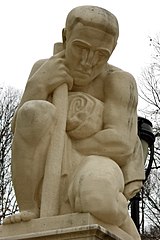
Heinz Warneke (June 30, 1895 – 1983) was an American sculptor best remembered as an animalier; his role in the direct carving movement "assured him a place in the annals of 20th-century American sculpture".[1] In 1935 Heinz received the Widener Gold Medal for his sculpture Wild Boars.
Early life and education
Warneke was born in Hagen bei Leeste, a small village near Bremen, Germany. He studied art at the Academy of Fine Arts in Berlin, Germany, where hi teachers included Karl Blossfeldt.[2][3]
Career
During World War I, Warneke was a member of the German Monuments Commission. In 1923, he moved to New York City.[4] From 1927 to 1932, he lived in Paris, where he created created a social realist, art-deco, and primitivism sculptures. When he returned to the U.S., Warneke undertook multiple commissions for the Works Progress Administration.[4]
He shared his skills with young art students by teaching sculpture at various institutions. From 1943 to 1968, Warneke taught at George Washington University and Corcoran School of Art in Washington, D.C.[5]
Death
Warneke died in Connecticut, in 1983.[4]
Selected works
- Wild Boars, Smithsonian American Art Museum in Washington, D.C., about 1931[6]
- The Prodigal Son, National Cathedral, Washington, D.C., built between 1932 and 1939[7]
- The Immigrant, Ellen Phillips Samuel Memorial, Fairmount Park in Philadelphia in 1933[8]
- Bears Playing, Harlem River Houses in New York City, 1938[9]
- Nittany Lion Shrine at Pennsylvania State University at Penn State University Park in 1942[10]
- African Elephant and Calf at the Philadelphia Zoo in Philadelphia in 1962[11]
- Elegance at the Smithsonian American Art Museum in Washington, D.C., 1927[12]
- Express Mail Carrier at the Smithsonian American Art Museum in Washington, D.C. in 1936[13]
-
The Prodigal Son (1932–39), National Cathedral in Washington, D.C.
-
The Immigrant (1933), Fairmount Park in Philadelphia
-
Bears Playing (1938), Harlem River Houses in New York City
-
Lewis & Clark Expedition (1939) at the Main Interior Building in Washington, D.C.
-
Nittany Lion Shrine (1942) at Pennsylvania State University in Penn State State College, Pennsylvania
References
- ^ Cunningham, Mary Mullen, Heinz Warneke (1895–1983): A Sculptor First and Last, University of Delaware, Newark, DE, 1994 p. 13
- ^ McGlauflin, Alice Coe, editor, Who's Who in American Art: Volume II, 1938–1939, The American Federation of Arts, Inc., Washington D.C., 1937. p. 548
- ^ Cunningham, Mary Mullen, Heinz Warneke (1895–1983): A Sculptor First and Last, University of Delaware, Newark, DE, 1994 p.22
- ^ a b c "Heinz Warneke Papers". Syracuse University Libraries. Retrieved February 24, 2015.
- ^ "Heinz Warneke". National Museum of American Art. Retrieved February 24, 2015.
- ^ "Wild Boars". Smithsonian American Art Museum.
- ^ Prodigal Son from SIRIS.
- ^ The Immigrant from SIRIS.
- ^ Bears Playing from SIRIS.
- ^ Nittany Lion from SIRIS.
- ^ African Elephant and Calf from SIRIS.
- ^ "Elegance by Heinz Warneke / American Art". Retrieved 21 October 2016.
- ^ "Express Mail Carrier by Heinz Warneke / American Art". Retrieved 21 October 2016.


















